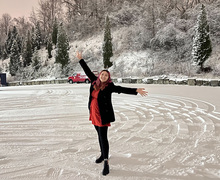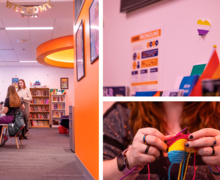SUFFP plants edible food forest in Syracuse’s South Side
Brycen Pace | Asst. Photo Editor
Syracuse Urban Food Forest Project volunteers planted culturally-significant Indigenous plants during its most recent event. The SUFFP was established in 2019 and aims to plant edible greenery in parks and public spaces throughout Syracuse.
Get the latest Syracuse news delivered right to your inbox.
Subscribe to our newsletter here.
While around 40 Syracuse University, SUNY ESF, and Syracuse community volunteers were occupied in the cultivation of a new edible food forest at Kirk Park, SU student Amy Bentley was only willing to pause due to a lack of shovels.
Bentley, an SU food studies master student and graduate research student with the Syracuse Urban Food Forest Project, waited patiently for her opportunity to assist in the planting event. As she waited, Bentley reflected on the role she was actively playing to help mitigate food insecurity — which roughly 45,000 people in Onondaga County suffer from.
“These kinds of planting events and putting edible species throughout our parks helps people regain agency over the food they’re getting for themselves, and help broaden the way we think about food,” Bentley said.
The SUFFP was established in 2019, connecting SU, ESF and the local community with the goal of planting “edible greenery in the city’s parks and public spaces,” according to the project’s website. Planting events consist of volunteers meeting up at selected public locations to plant trees, fruits and vegetables freely available to the surrounding community.
During its most recent event on Oct. 24, volunteers gathered to plant culturally-significant Indigenous plants, including persimmon, bur oak, juneberry, pawpaw chokecherry, currants and elderberry. The project’s Facebook page said that 60 trees, 35 shrubs and 100 perennials were planted during the event.
Baked goods and tea made from some of these foraged plants were served for volunteers in collaboration with Scratch Bakehouse Head Baker Corey Bruce. The event was organized by the SUFFP in collaboration with the United States Forest Service and the Onondaga Earth Corps.
Anne Bellows, a professor in SU’s Food Studies program and a founding organizer of SUFFP, said she was inspired to create the project to bring the community and environment closer together. She said the edible forests aim to provide food for people while also creating migratory spaces for other wildlife, creating “reciprocity” between man and nature.
Since receiving the Great Lakes Restoration Initiative grant in 2022, SUFFP has increased its investment in educational events, research of foraging habits and the nutritional aspect of foregable species and organized community planting events.
She also said the organization has focused its efforts on a nine-mile corridor connecting the Inner Harbor area, following the creek to Onondaga Community College’s campus.
“We get most of our food from the grocery store, whereas for thousands of years, humans have been able to get their food from the plants around them,” Bentley said. “The Urban Food Forest Project is trying to bring those kinds of relationships back into the city by planting species that we can forage from in places that people have access to.”

Brycen Pace | Asst. Photo Editor
Throughout the event, volunteers planted persimmon, elderberry, bur oak, pawpaw chokecherry, currants and juneberry. The project’s events consist of volunteers meeting in public locations and planting trees, fruits and vegetables available to the surrounding community.
Tay Stenson, a program coordinator for the Onondaga Earth Corps, said he hopes that, as this region is restored, the community can connect to the forests and harvest from them. Since Syracuse is home to multiple food deserts — areas with limited access to affordable, fresh food — Stenson said the initiative helps to provide residents with sustainable and healthy food options.
“What we’re all about is supporting our own communities, educating our community (and) making sure that our people are not just surviving, but thriving,” Stenson said. “And that is what SUFFP is doing here.”
Bellows and Stenson agreed that while gardens like this don’t directly fix Syracuse’s food desert problem, they help bring some relief and ecological integrity to underinvested neighborhoods.
Bellows said there is a “racial and ethnic apartheid” in Syracuse that is tied to investment, and that the Valley Plaza Shopping Center – where SUFFP bases its efforts – hasn’t had a full service grocery store for years. This investment disparity makes access to nutritional foods difficult in Syracuse’s South Side neighborhood, so edible gardens contribute to developing a healthier source of food.
Food Access Healthy Neighborhoods Now will be hosting a farmers market starting Nov. 23, located in the Valley Plaza in an effort to get fresh produce to the South Side, Bellows said. SUFFP will be tabling at the event with project information and baked goods.
“They’re always putting up Family Dollars, always putting up Dollar Generals … they help out folks a lot, but you can’t get anything nutritious,” Stenson said. “I’m hoping (these sites) will give people the idea and the hope to start their own edible gardens right in their backyard.”
Published on October 28, 2024 at 12:22 am






